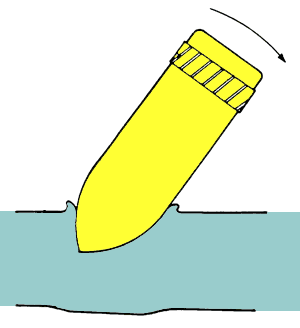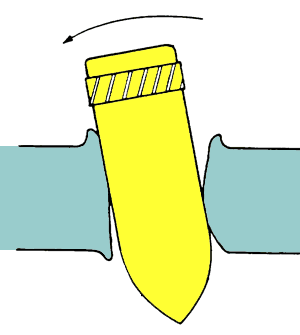
Logo from Scott Cunningham.

Logo from Scott Cunningham.
 hen the ogive enters the plate, it first of all experiences a greater thrust on the side away from the normal, both because a greater area is in contact with the plate, and because displacement of plate material on that side of the head is more difficult. Consequently, the projectile experiences a turning moment which causes it to swing away from the normal.1
hen the ogive enters the plate, it first of all experiences a greater thrust on the side away from the normal, both because a greater area is in contact with the plate, and because displacement of plate material on that side of the head is more difficult. Consequently, the projectile experiences a turning moment which causes it to swing away from the normal.1

The first reaction against a projectile is to turn away from the armour plate. Diagram from 1.
As penetration proceeds, a stage is reached at which the plug begins to shear out, and as a result the thrust of the side of the ogive remote from the normal is decreased, while that on the other side of the head becomes relatively high. Therefore, at this stage the projectile starts to swing back towards the normal.1

The second reaction against a projectile is to turn it back towards the vertical. Diagram from 1.
When the forward part of the projectile passes through the hole formed in the plate, the angular velocity of the projectile will be destroyed rapidly by impact of the projectile body against the sides of the hole.1

Once the plug has been sheared out the projectile violently strikes the side of the hole. Diagram from 1.
The bending stresses imposed by this sudden retardation are likely to be greater than those associated with either the initial turn away from normal or subsequent swing back. It is probable that the tensile stresses produced in the projectile’s side by this violent angular retardation are responsible for many of the observed cases of shot break-up at angles of attack of 30° or more.1
 The Effect of Projectile Head Shape
The Effect of Projectile Head Shape
Do you like this web site? Please rate it between one and ten, with ten being the best:
Ratings are submitted to: The Wargames and Military History Search Engine.
Copyright © 2000 David Michael Honner. E-mail: GvA@wargamer.org.